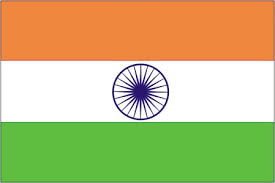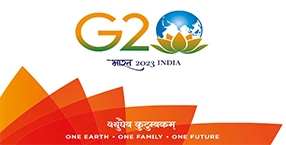In a Nutshell
The Republic of Austria is located in southern Central Europe. With an area of 84,000sqkm (approximate size of Arunachal Pradesh) and population of 9,1 million (as of 1.1.2023), it encompasses the Eastern Alps and the Danube Region. Austria has been at crossroads of travel routes between the major European economic and cultural regions. Austria is land-locked, sharing borders with 8 countries: Germany, Czech Republic, Slovakia, Hungary, Slovenia, Italy, Switzerland & Liechtenstein. Austria is a federal state comprising 9 provinces: Burgenland Carinthia, Lower Austria, Salzburg, Styria, Tyrol, Upper Austria, Vienna and Vorarlberg.
Austria became an important force in central Europe with the formation of the Habsburg Austro-Hungarian Empire in the 15th century. Following its defeat in World War I, the former Empire gave way to the present-day Republic. New constitution was adopted in 1918. Democracy was suspended in 1933; German Reich occupied Austria from 1938-1945. After WW II, Austria participated in the Marshall Plan. The 1955 State Treaty — that granted sovereignty from Allied powers – declared the country ‘permanently neutral’. Austria is a member of the European Union since 1995, and adopted the Euro currency since its introduction in 2002.
Austria is a democratic republic with a bicameral Parliament. The 183-member National Council (Nationalrat) is elected directly by the people. The 64 members of the Federal Council (Bundesrat) are delegated by the provincial parliaments. Head of state is the President (Bundespräsident) Mr. Alexander Van Der Bellen (since 26 January 2017). Head of Government is the Federal Chancellor (Bundeskanzler) Mr. Karl Nehammer (since 6 December 2021).Austria is currently ruled by a coalition of the Austrian People's Party and the Die Grünen (The Greens). The Cabinet consists of Ministers from the Austrian People's Party (ÖVP)-Green coalition. Mr. Werner Kogler from the Greens Party is the Vice-chancellor of Austria.
Around 65% of the population is urban. 98% of the Austrians speak German. 78% are Roman Catholic, 5% Protestant, 9% non-denominational. The ethnic minorities in Austria include — Croats, Slovenes, Magyars, Czechs, Slovaks and Roman. Population growth rate is estimated at 0.25%. Vienna, Graz, Salzburg and Innsbruck are the main Austrian cities. Austria has 18 universities. The University of Vienna, one of the oldest universities in Europe, was founded in 1365.
The average temperature in summer is around 20°C with maximum temperatures of around 35°C. In winter temperatures can be as low as –15°C, although the average is around -4°C. There can be especially heavy snowfall in the mountain regions. Highest rainfall is in May and June.
The most important waterway is the Danube. The largest lake is the Neusiedel Lake in Burgenland - around 77% of its total area of 315 km² is in Austria, the rest is part of Hungary. The Attersee Lake has an area of 46 km², the Traunsee is 24 km². Also, a part of Lake Constance (Bodensee), 24 km², lies in Austria (from a total area of 536 km²).
Natural resources in Austria include iron ore, lignite, crude oil and natural gas, magnesite, silica sand, Gypsum, lead and zinc ore, Graphite and Kaoline. Leading industries include Machinery and parts, Electrical machinery and equipment, Optical, precision and medical equipment, Iron and Steel, Railway locomotives, Railway track fixtures and fittings. Many of the country’s largest firms were nationalized in the early post-war period. Since early 1990s a great number of these have been privatized. Austria has high quality tourist assets (natural beauty, alpine ski resorts and rich cultural heritage). The capital Vienna is a vibrant cultural city. It was home to many great classical music composers – Mozart, Beethoven, Schubert, Strauss family as also several thinkers and philosophers (e.g. Freud). 16 Austrians have so far been awarded the Nobel Prize. Vienna hosts several multilateral organizations including OSCE, IAEA, UNIDO, UNDCP and OPEC, OOSA, UNODC, INCB, UNCITRAL, etc.
Economy
According to the Austrian National Bank, the real economic growth amounted to 4.8 % in 2022. The real GDP growth reached -0.7 % in 2023. In 2024, growth is expected at 0.6% as the current business cycle runs its course. The unemployment rate will rise marginally with 0.3 percentage point to 6.8 % in 2024. The HICP inflation willreach 7.7% in Austria in2023, a level well abovethe euro area average.This is mainly due to thelagged pass-through offalling energy prices, aswell as strong servicesand food price inflation.Inflation is expected tocome down to 4.0% and 3.0%, respectively,in 2024& 2025 as energy price pressures ease.
Austrian National Bank (OeNB)December 2023 Economic Outlook for Austria
Key Results
| 2022 | 2023 | 2024 | 2025 | |
|---|---|---|---|---|
| Annual change in % | ||||
| Economic activity | ||||
| Gross domestic product | 4.8 | -0.7 | 0.6 | 1.7 |
| Unemployment rate (national definition) | 6.3 | 6.5 | 6.8 | 6.6 |
| Exports of goods and services | 11.6 | 1.8 | 1.5 | 2.2 |
| Imports of goods and services | 8.1 | -1.3 | 2.2 | 2.6 |
| % of nominal GDP | ||||
| Current account balance | -0.3 | 2.4 | 2.1 | 2.3 |
| Annual change in % | ||||
| Prices | ||||
| Harmonised Index of Consumer Prices (HICP) inflation | 8.6 | 7.7 | 4.0 | 3.0 |
| Annual change in % | ||||
| Income and savings | ||||
| Real disposable household income | 3.1 | -2.8 | 3.8 | 2.6 |
| % of nominal disposable household income | ||||
| Saving ratio | 9.0 | 6.4 | 8.2 | 8.9 |
| Annual change in % | ||||
| Labor market | ||||
| Total employment (persons) | 2.6 | 0.9 | 0.5 | 1.0 |
| % Of labor supply | ||||
| Unemployment rate (Eurostat definition) | 4.8 | 5.3 | 5.5 | 5.3 |
| % of nominal GDP | ||||
| Budget balance | ||||
| Budget balance (Maastricht definition) | -3.5 | -2.6 | -2.7 | -2.8 |
| Government debt | 78.4 | 76.6 | 76.4 | 75.6 |
India and Austria
Austria, a member of the European Union since 1995 is an important link for India in its relationship with Europe, especially with countries of central and Eastern Europe. The Indo-Austrian Joint Economic Commission (JEC) established in 1983 is active and on-going (16th session was organized in Austria on 12-13 June 2023) between the governmental Ministries and Chambers of Commerce and Industry of the two countries. There has been cooperation in the fields of steel, manufacturing technology, railway and transport, renewables, equipment, metallurgy through a large number of collaborations, technology transfers and joint ventures.
India's main exports to Austria are Footwear, Textiles, Articles of Leather, Articles of Apparel and Clothing Accessories, Vehicles, Rolling Stock (And Parts and Accessories Thereof), Machinery and Mechanical Appliances (And Parts Thereof), Electrical Machinery and Equipment, Organic Chemicals and Pharmaceutical Products.
The latest figures of India-Austria bilateral trade are: (Billion US$)
| Year | Indian Exports | Diff. in % | Indian Imports | Diff. in % | Total trade | Diff. in % (total- trade) | Trade Balance |
|---|---|---|---|---|---|---|---|
| 2019 | 1.14 | 1.02 | 2.16 | 0.12 | |||
| 2020 | 1.06 | -7.01 | 0.99 | -2.94 | 2.05 | -5.09 | 0.07 |
| 2021 | 1.29 | 21.69 | 1.18 | 19.19 | 2.47 | 20.48 | 0.11 |
| 2022 | 1.61 | 24.80 | 1.23 | 4.23 | 2.84 | 14.97 | 0.38 |
| 2023 | 1.52 | -5.59 | 1.40 | 13.82 | 2.92 | 2.81 | 0.12 |















